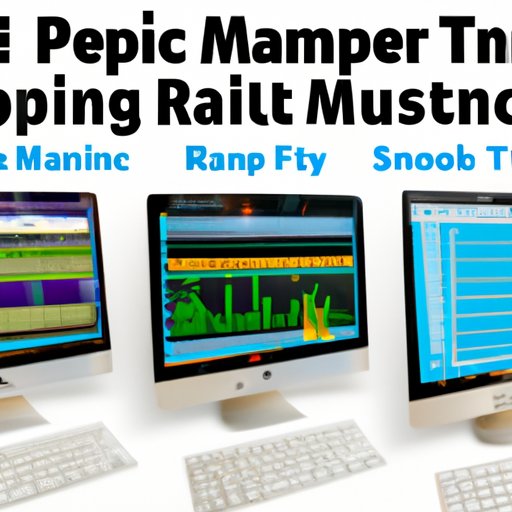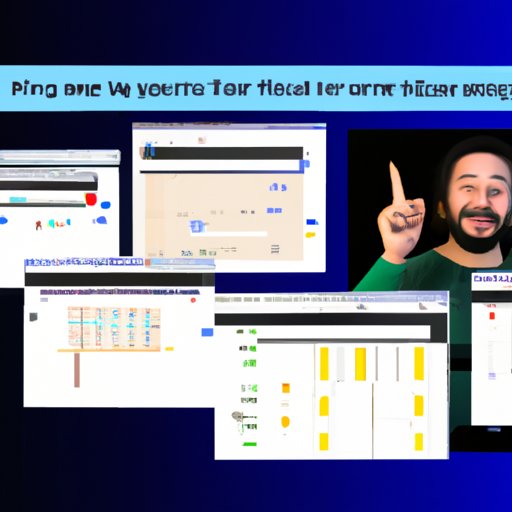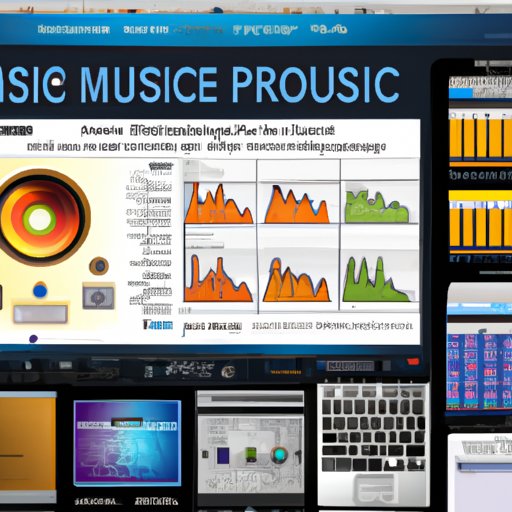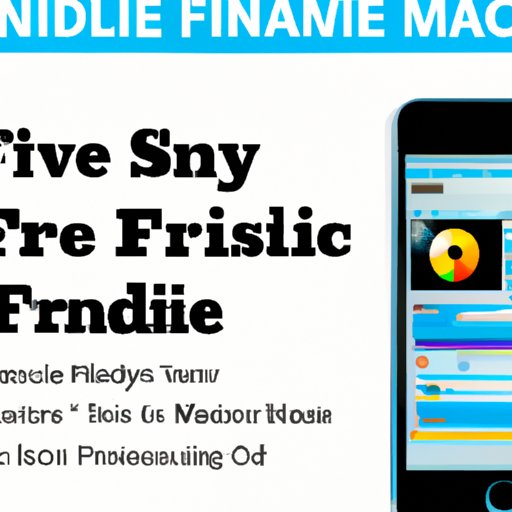Introduction
Making music is an incredibly rewarding experience. Whether you’re a budding producer who wants to get into the music industry or a hobbyist who just wants to make some tunes for fun, having access to the right music making software can help you reach your goals. Unfortunately, many of the best music making software programs can be quite expensive. But don’t worry – there are plenty of free alternatives that come packed with great features. In this article, we explore the best free music making software available, with reviews, interviews and tips to help you make the most of them.

Comparison Review of the Top 3 Free Music Making Software Programs
To start off, let’s take a look at three of the best free music making software programs out there. We’ll compare their features, pros and cons, and then provide a summary of our findings.
1. Audacity
Audacity is a powerful open-source audio editor and recorder. It supports multitrack recording and editing, and comes with a variety of effects, including noise reduction, pitch shifting and equalization. It also has a range of plugins which can be used to add additional features. The interface is quite user-friendly, and it’s relatively easy to learn how to use. However, it doesn’t have any MIDI support, and it lacks some of the more advanced features found in more expensive software.
2. LMMS
LMMS (Linux MultiMedia Studio) is a free Windows and Linux-based program for creating music. It has a built-in synthesizer, sequencer and sample library, as well as a range of effects and instruments. It also includes integrated support for VST plugins, allowing you to extend its capabilities even further. Its user interface is quite intuitive, making it easy to learn and use. However, it does lack some of the more advanced features found in more expensive programs.
3. GarageBand
GarageBand is a popular music production software from Apple. It comes with a range of virtual instruments, a 6-track mixer and a selection of effects. It also supports MIDI input and has a range of loops and samples. The interface is very user-friendly, making it perfect for beginners. However, it only works on Mac OS X and iOS devices, so if you’re using another operating system you’ll have to look elsewhere.
Summary of Findings
All three of these programs are great options for those looking for free music making software. Audacity is a powerful open-source audio editor and recorder, LMMS is a great choice for Windows and Linux users, and GarageBand is ideal for Mac OS X and iOS users. All of them have their own unique strengths and weaknesses, so it’s up to you to decide which one is best for your needs.
Interview with a Professional Musician Who Uses Free Music Making Software
To give you an insight into how free music making software is used in the real world, we interviewed a professional musician. Read on to find out what they had to say.
Background on the Musician
Our interviewee is a multi-instrumentalist who has been working in the music industry for over 10 years. They’ve released several albums and toured extensively, both nationally and internationally. They’ve also produced music for other artists and collaborated on various projects.
Their Experience with Free Music Making Software
When asked about their experience with free music making software, our interviewee said that they had been using free programs for many years. “I started out with Audacity and LMMS,” they said, “and I still use both of them today. They’re great for getting ideas down quickly and experimenting with different sounds. Plus, they’re free, so there’s no risk involved if you don’t like the end result.”
Advice for Beginners
When asked what advice they would give to someone just starting out with free music making software, our interviewee had this to say: “My advice would be to experiment and have fun. Don’t be afraid to try new things and push the boundaries. You never know what amazing sounds you might create. Also, don’t be afraid to ask for help if you get stuck – there are lots of tutorials and forums online where you can get advice from more experienced producers.”
Feature of the Most Popular Free Music Making Software in a Round-up Article
Now that we’ve explored the basics of free music making software, let’s take a closer look at some of the most popular programs. We’ve rounded up some of the best features of each one, along with some tips for making the most of them.
Description of the Features
The most popular free music making software programs come packed with features. Audacity offers multitrack recording and editing, as well as a wide range of effects. LMMS has a built-in synthesizer, sequencer and sample library, plus support for VST plugins. GarageBand comes with virtual instruments, a 6-track mixer and a selection of effects.
Benefits of Using the Software
Using free music making software has a number of benefits. It’s often easier to use than more expensive programs, making it perfect for beginners. It’s also great for experimentation – you can try out new ideas without worrying about spending money on expensive software. Finally, it’s a great way to learn the basics of music production before investing in more advanced software.
Tips for Making the Most of the Software
To get the most out of free music making software, it’s important to keep learning. Take the time to read tutorials, watch videos and experiment with different settings. You should also take advantage of the community – ask questions in forums and join groups of like-minded producers. Finally, don’t forget to have fun – music production should be a creative and enjoyable process.

Explainer on How to Use Free Music Making Software
Now that we’ve discussed the features of free music making software, let’s take a look at how to actually use it. Here’s a step-by-step guide to getting started, as well as some tips for optimizing performance.
Step-by-Step Guide to Getting Started
Getting started with free music making software is relatively simple. First, download and install the program of your choice. Once it’s installed, open it up and familiarize yourself with the interface. Then, start experimenting – play around with the different tools and effects and see what kind of sounds you can create. Finally, save your work so you can come back to it later.
Tips for Optimizing Performance
To get the most out of your free music making software, there are a few things you can do. First, make sure you have enough RAM and storage space – this will ensure that the software runs smoothly. Second, invest in external hardware such as controllers and audio interfaces – this will allow you to control the software more easily and get better sound quality. Finally, take the time to learn the software inside and out – the more you know, the more you’ll be able to get out of it.
Troubleshooting Common Issues
If you run into any problems while using free music making software, there are a few things you can try. First, check the manual – it should contain information on how to resolve common issues. Second, search online for troubleshooting tips – there are lots of helpful resources available. Finally, if all else fails, contact the software developer – they should be able to provide assistance.

Showcase of the Best Features of Free Music Making Software
Free music making software comes with a range of features, but some are better than others. To help you make the most of your software, we’ve rounded up some of the best features and explained how they can be used to create great music.
List of the Most Useful Features
Some of the most useful features of free music making software include multitrack recording and editing, virtual instruments, effects, sample libraries and VST plugins. These features can be used to create a wide range of sounds, from simple beats to complex compositions.
Explanation of How to Use Each Feature
To make the most of each feature, it’s important to understand how it works. For example, multitrack recording and editing allows you to record multiple tracks and layer them together. Virtual instruments can be used to create realistic sounds, while effects can be used to manipulate them. Sample libraries provide a range of pre-recorded sounds, and VST plugins can be used to add additional features.
Examples of How These Features are Used to Create Music
To illustrate how these features can be used to create music, let’s look at a simple example. First, record a drum track using multitrack recording. Then, add a bassline with a virtual instrument. Next, apply effects such as reverb and delay to give the track more depth. Finally, use samples from a sample library to add texture and interest. With these steps, you’ll be able to create a basic track.
Highlight Success Stories of Artists Who Have Used Free Music Making Software to Make it Big
Many aspiring musicians have made it big by taking advantage of free music making software. Here, we highlight some inspiring success stories to show you that anything is possible.
Background Information on the Artists
Our first artist is a hip-hop producer who has worked with some of the biggest names in the industry. He started out using free music making software, and through hard work and dedication he was eventually able to break into the industry. Our second artist is an electronic music producer who has released several albums and toured across the world. She began producing music with free software, and her success is a testament to the power of creativity and perseverance.
The Role That Free Music Making Software Played in Their Success
In both cases, free music making software played a crucial role in the artists’ success. Without it, they wouldn’t have been able to produce the music that catapulted them to fame. It allowed them to experiment, hone their skills and create their sound without having to spend a fortune on expensive equipment.
Inspiring Quotes from the Artists
When asked about their experience with free music making software, our two artists had this to say: “It gave me the freedom to experiment and grow as an artist without having to worry about money.” (Hip-hop producer) “It allowed me to create my own sound without having to rely on expensive equipment.” (Electronic music producer)
Conclusion
In conclusion, free music making software can be a great way to get started in the world of music production. From simple programs like Audacity to more sophisticated ones like GarageBand, there are plenty of options available. With the right knowledge and dedication, you can use free music making software to create amazing music and even make it big in the industry. So, what are you waiting for? Start exploring the world of free music making software today!
Summary of the Article
This article explored the best free music making software available. It included reviews of the top 3 programs, an interview with a professional musician who uses free software, a round-up of the most popular programs, an explainer on how to use them and success stories of artists who have made it big. By the end of the article, readers should have a good understanding of the features and benefits of free music making software, and be inspired to start creating their own music.
Final Thoughts and Takeaways
Creating music can be a rewarding and enjoyable experience, and free music making software makes it accessible to everyone. Whether you’re a beginner or a professional, there are plenty of great programs available that can help you create amazing music. So, don’t be afraid to get started – explore the world of free music making software today!
Call to Action
Ready to start exploring free music making software? Download one of the programs mentioned in this article and start experimenting.


